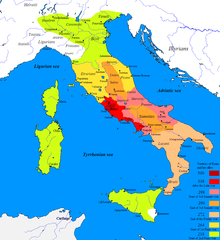| Millennium: | 1st millennium BC |
|---|---|
| Centuries: | |
| Decades: | |
| Years: |
| 218 BC by topic |
| Politics |
|---|
| Categories |
| Gregorian calendar | 218 BC CCXVIII BC |
| Ab urbe condita | 536 |
| Ancient Egypt era | XXXIII dynasty, 106 |
| - Pharaoh | Ptolemy IV Philopator, 4 |
| Ancient Greek era | 140th Olympiad, year 3 |
| Assyrian calendar | 4533 |
| Balinese saka calendar | N/A |
| Bengali calendar | −810 |
| Berber calendar | 733 |
| Buddhist calendar | 327 |
| Burmese calendar | −855 |
| Byzantine calendar | 5291–5292 |
| Chinese calendar | 壬午年 (Water Horse) 2480 or 2273 — to — 癸未年 (Water Goat) 2481 or 2274 |
| Coptic calendar | −501 – −500 |
| Discordian calendar | 949 |
| Ethiopian calendar | −225 – −224 |
| Hebrew calendar | 3543–3544 |
| Hindu calendars | |
| - Vikram Samvat | −161 – −160 |
| - Shaka Samvat | N/A |
| - Kali Yuga | 2883–2884 |
| Holocene calendar | 9783 |
| Iranian calendar | 839 BP – 838 BP |
| Islamic calendar | 865 BH – 864 BH |
| Javanese calendar | N/A |
| Julian calendar | N/A |
| Korean calendar | 2116 |
| Minguo calendar | 2129 before ROC 民前2129年 |
| Nanakshahi calendar | −1685 |
| Seleucid era | 94/95 AG |
| Thai solar calendar | 325–326 |
| Tibetan calendar | 阳水马年 (male Water-Horse) −91 or −472 or −1244 — to — 阴水羊年 (female Water-Goat) −90 or −471 or −1243 |

Year 218 BC was a year of the pre-Julian Roman calendar. At the time it was known as the Year of the Consulship of Scipio and Longus (or, less frequently, year 536 Ab urbe condita). The denomination 218 BC for this year has been used since the early medieval period, when the Anno Domini calendar era became the prevalent method in Europe for naming years.